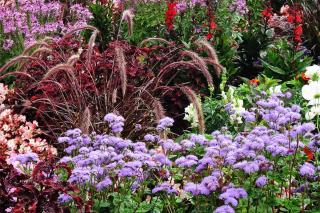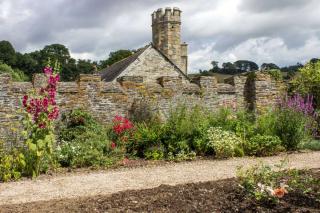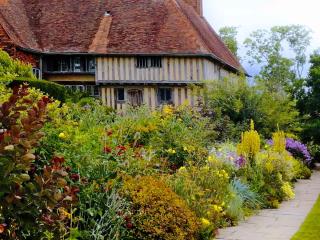

Lively, colorful and evolving as seasons come and go, a mixed border is a brilliant combination of perennials, annuals, shrubs and grasses.
Reminiscing of the best in garden fashion of the British Isle, the mixed border introduces a touch of countryside living to the garden.
 As its name shows, a mixed border is a shrub bed that usually lines the sides of a garden plot. It marks the border with the neighbor‘s lot. A selection of different shrubs, flowers and working on different levels are what make it “mixed”. On the back side of a mixed border, you’ll usually find a fence, hedge, or low wall.
As its name shows, a mixed border is a shrub bed that usually lines the sides of a garden plot. It marks the border with the neighbor‘s lot. A selection of different shrubs, flowers and working on different levels are what make it “mixed”. On the back side of a mixed border, you’ll usually find a fence, hedge, or low wall.
Clusters of leaves and colorful flower clumps soften hard edges of property lines and helps create a cozy, intimate oasis of greenery. It’s also possible to set up mixed border alongside the house, against a wall, to really savor their artistry. They do need a certain depth, though, so allow for rather wide beds as you draw up your garden. The main reason for this is that different plants of varying height are planted one behind the other, rising from low in front to taller in the rear.
 It’s all about balance! At first glance, most mixed border beds have an uncanny resemblance to unkempt, neglected wild flower beds. In reality, it’s quite the opposite! This type of garden bed is often thought through in depth by the astute garden master. The beauty of a tall wildflower emerging from the fray is made possible thanks to the presence of low, evergreen shrubs and throngs of bushy grasses.
It’s all about balance! At first glance, most mixed border beds have an uncanny resemblance to unkempt, neglected wild flower beds. In reality, it’s quite the opposite! This type of garden bed is often thought through in depth by the astute garden master. The beauty of a tall wildflower emerging from the fray is made possible thanks to the presence of low, evergreen shrubs and throngs of bushy grasses.
Every plant has a role to play. First of all, compose the background. That is where you’ll place bushy climbing vines and a few very tall grasses. The bed should also boast flowers that bloom in different stages, from spring to fall, and even winter. These spots of color truly catch the eye again and again as months whittle by.
 Perfect examples for a first mixed border bed are Mexican orange or spindle. These indeed have evergreen foliage that will structure the bed throughout the year. They form an excellent backdrop that hides the back of the bed and provide depth and volume.
Perfect examples for a first mixed border bed are Mexican orange or spindle. These indeed have evergreen foliage that will structure the bed throughout the year. They form an excellent backdrop that hides the back of the bed and provide depth and volume.
Against a wall, prefer a lattice with climbing vines instead. Climbing rose trees and Solanum false jasmine will provide great cover and release a delicious fragrance when in bloom. Dot the space between shrubs at the back of your growing bed with tall, ornamental grasses such as Calamagrostis or Miscanthus.
For the next step we’ll consider a few lower-growing plants, between 1½ and 3 feet tall. This is where we focus on flowers that will liven up the whole bed.
Why not chose a few different types of columbine for a happy spring blooming? After they finish blooming, summer-blooming veronica will take over. Those will, in turn, be superseded by beautiful Echinaceae with their extended blooms that trail deep into autumn. Here and there, add a couple bulbs that emerge in spring for blooming anemone and in fall for Dahlia.
At the lowest level, plunking a few clumps of Stipa and Santolina wraps the composition up with style.
 Many plants love spending their whole lives in full sun. How should you set up a mixed border in full sun? What if the area is very dry?
Many plants love spending their whole lives in full sun. How should you set up a mixed border in full sun? What if the area is very dry?
For shrubs, a Grevillea is an excellent answer. It grows very dense and blooms with surprising red flowers. Among the perennials that do well in dry soil, Acanthus stands out thanks to its massive leaves. It paints a dramatic scenery, especially as its towering flower scapes start reaching for the sky.
Achillea are also great fall-back options, since they’re generally very happy in full sun whatever the type of soil. Yellow, pink, white… their joyful flowers will color the bed from June to September.
As regards grasses for dry, sun-bathed locations, possibilities range from pampas grass with its tall fluffy stalks to Muhlenbergia capillaris and its vapor-wave aesthetic pink blooming.
At soil level, where it’s a bit cooler, Pennisetum or Carex flagellifera will do just fine in the sun. Sun-loving bulbs exist, too: ornamental onion loves sun and soil that drains very well.
 Don’t despair if your growing bed is always in the shade! Here is a great selection of shade-loving plants for your mixed border.
Don’t despair if your growing bed is always in the shade! Here is a great selection of shade-loving plants for your mixed border.
Aucuba japonica is an evergreen shrub that loves simple, shade-covered corners. What makes it appealing is the occasional variegated leaves mottled with yellow spots. Climbers, in this context, should include ivy or hydrangea, noted for its summer blooming. Two low-lying flowers will bring the finishing touch to this shaded mixed border:
All varieties of Carex do well in the shade, so choose the hue that pleases you most: yellow, variegated, or even blue for some varieties. Ophiopogon is also worth considering: jet-black foliage will make you think the world is black and white if you plant it next to white Trillium. At the bottom of this setup, Epimedium and light-colored cyclamen keep the soil cool and covered.
Many of these plants readily self-sow. Take a few pictures as years come and go, you’ll see your mixed border evolve as time passes!